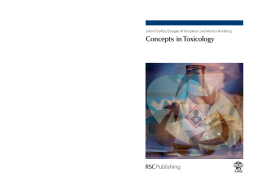
Additional Information
Book Details
Abstract
Toxicology has never been more important. Advances in chemistry and technology offering improvements in the quality of human life become ever more rapid, bringing with them the potential for new toxicity hazards. This has led to legislation requiring toxicity testing and risk assessment for all chemicals and their uses. The new REACH (Risk Evaluation and Authorization of Chemicals) Regulation has profound economic consequences because, without official authorization, a chemical cannot be marketed. This book explains, in depth, the ideas underlying current advances in toxicology and its application in regulating and ensuring the safe use of chemicals. Sometimes old ideas have become assumptions that have become embedded in related laws and regulation, even though the thinking of toxicologists has moved on in line with developments in science. This leads to confusion in public understanding that the book should dispel. There are also fundamental ideas in toxicology that are not well understood concerning the concepts of hazard and risk and even about what constitutes a chemical. For many people the word 'chemical' describes manmade substances only. In fact, it is correctly applied to all substances that exist, from pure elements to the most complex biological molecules in food and medicines. This is further complicated by the complex distinction between the descriptors, 'toxic' and 'nontoxic'. Developments in epigenetics are revolutionizing our understanding of mutagenicity and carcinogenicity. Improved understanding of apoptosis and necrosis leads to improved interpretation of potentially toxic effects at the cellular level. The recently defined term 'chemical speciation' is driving more targeted research on the toxicity of inorganic chemicals. This book explains the concepts implied by key toxicological terms using diagrams to illustrate the relationships between them. It is an essential aid to understanding the new demands from regulators of risk assessment and to the implementation of appropriate risk management.
J H Duffus (BSc, PhD, DSc, CChem, FRSC, CSci, CBiol) is based at the Edinburgh Centre for Toxicology. He has acted as a consultant to the International Programme on Chemical Safety, the World Health Organization and the European Commission as well as to various industrial bodies and various law firms. Dr Duffus is a member of the Royal Society of Chemistry Environment, Health, and Safety Committee and the Subcommittee on Toxicology and Risk Assessment. He is also currently Chair of the International Union of Pure and Applied Chemistry (IUPAC). As well as being included in the Institute of Biology Register of Environmental Biologists and UK Register of Expert Witnesses, he is a fellow of the Royal Society of Chemistry and a member of numerous scholarly societies. He has also contributed to numerous scientific publications. Monica Nordberg is a Professor in the Institute Environmental Medicine at the Karolinska Institute in Stockholm. She has acted as a consultant to the International Programme on Chemical Safety, World Health Organization, Indian Medical Research Council and US National Academy of Science. Professor Nordberg is also Chair of the Scientific Committee on the Toxicology of Metals (International Commission on Occupational Health), Swedish Representative of the EU Strategy on Environment and Health, Technical Working Group on Indicators and Priority Diseases and project leader on several IUPAC initiatives. She is a member of several academic societies, the editorial boards of a number of learned journals and has contributed to numerous books and journals in the field. Douglas M. Templeton is a Professor in the Faculty of Medicine at the University of Toronto He is President of IUPAC division VII (Chemistry and Human Health), Chair of the Medical Advisory Committee of the Thalassemia Foundation of Canada, Past Chair of the Pharmacology and Toxicology Grants Panel of the Canadian Institute of Health Research and has taken on various consultancies in the Pharmaceutical and Mining Industries. He has also contributed to numerous books and journal articles.
